 Such movies as “Game of Thrones” are truly special. Mysteries, hidden symbolism, meaningful personalities, and well thought-out decorations – everything in this series begs for our attention and elucidation. And, of course, the stage costumes of characters are one of the most interesting components of this imaginary world. In this article, we’ll take a deep dive into the hidden symbols and meanings of the stage costumes and jewelry in “Game of Thrones” series.
Such movies as “Game of Thrones” are truly special. Mysteries, hidden symbolism, meaningful personalities, and well thought-out decorations – everything in this series begs for our attention and elucidation. And, of course, the stage costumes of characters are one of the most interesting components of this imaginary world. In this article, we’ll take a deep dive into the hidden symbols and meanings of the stage costumes and jewelry in “Game of Thrones” series.
Read also:
Costumes of Jon Snow from Game of Thrones. Are they historically accurate?
Stage costumes of Olenna Tyrell from Game of Thrones. She’s got charming pillbox hats with wimples
GOT Red Wedding show costumes. Let’s recall the top-10 lovely and weird outfits
This material is based on the video from YouTube channel “Costume CO”.
Sansa’s pendant
In Season 4, Sansa presents herself in a new look (often referred to as “Dark Sansa”), an outfit that she's created from found materials in The Eyrie.
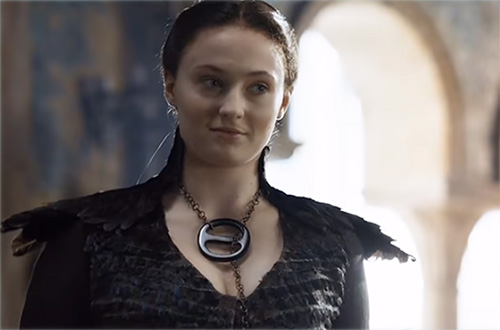
She’s wearing an unusual jewelry piece. This pendant looks a bit like a belt buckle. Some people already tried to find out what the shape of this jewelry means. For instance, the youtuber ScreenPrism (now – “The Take”) have equated the circle divided by a line with the Greek letter Φ, φ. This symbol also represents the “golden ratio”, sometimes called the “golden mean” or “golden section”. While it's a mathematical formula, it has been used in both art and architecture.
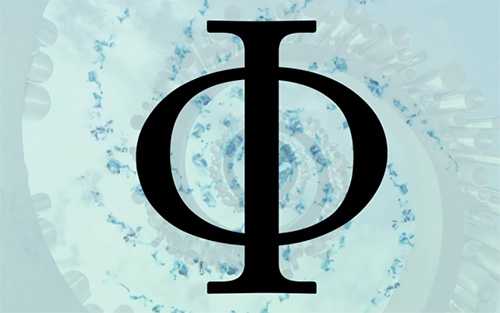
Also, you might have noticed that the symbol is even contained within the “Game of Thrones” logo itself.
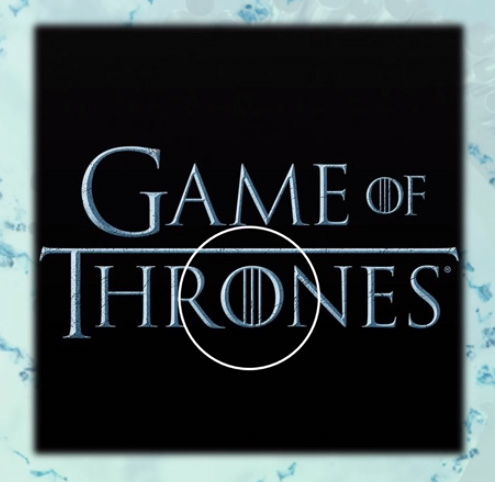
And we've seen the shape before to a certain extent in these annular brooches worn by the main characters.
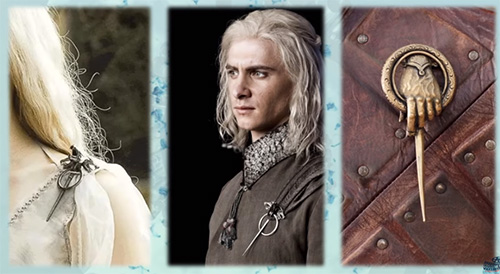
Actually, the costume designer Michele Clapton likes to wear similar adornments – these circular pendants but without the center bar.
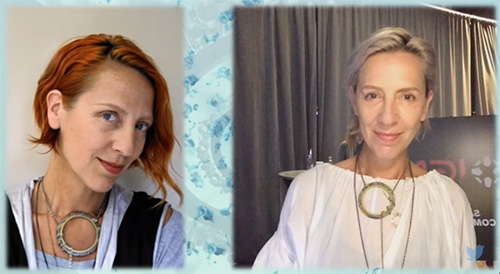
Some fans of the show believe that the jewelry piece might represent the Moon Door, located in the High Hall of the Eyrie – a hatch built into the floor through which people can fall to their deaths. Production designers created this specifically for the show.
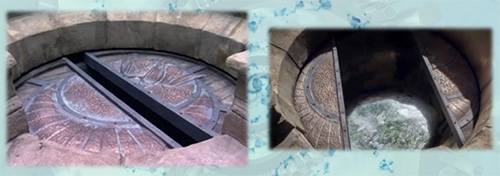
And we saw similar symbols with the circle and cross on the left – of formation of bodies left by the White Walkers, and on the right – a Dothraki funeral pyre, the one that Danny survives unburnt.

Showrunners Dave and Dan tell us that these symbols are intentional, that these ancient symbols used by the White Walkers lead back to the symbols used by the Children of the Forest around the Weirwood tree.
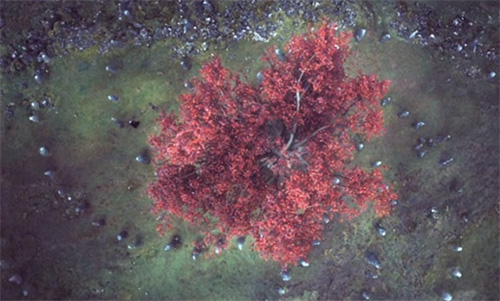
And then in Season 7, we witness these ancient symbols carved onto a wall of a Dragonstone cave, thought to be made by the Children of the Forest thousands of years ago.
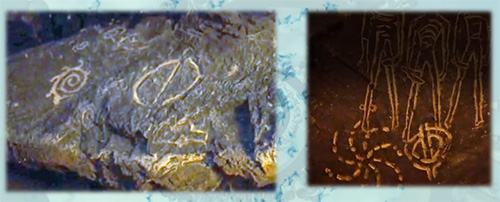
According to some forms of interpretation, this circle line symbol is a masculine or feminine element depending on its direction. This symbol on the left, with the horizontal line, indicates the passive female element and what has been there since the beginning of time and all things. While the symbol on the right, with a vertical bar, represents the active male element indicating what comes on from high and the effective element in time.

So where does this leave us with Sansa's pendant? It's not certain, because her pendant is wonky and doesn't necessarily sit in one direction. We might take some hint from Michele Clapton's original sketch, which shows that the bar is definitely vertical, indicating an active male element.
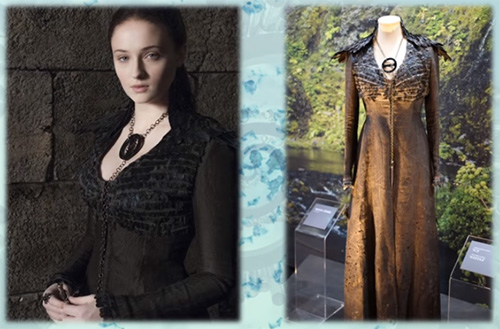

Hexagon symbol
We first meet Melisandre in Season 2 in the episode “The North Remembers”. Melisandre wears a choker made from interconnected 6-sided shape polygons called “hexagons”. In the center of the choker is a ruby stone, the likely source of her youth and longevity.

And the hexagon was a purposeful choice by costume designer Michele Clapton. In an interview with New York Magazine, Compton said, “I wanted something that was so quickly identifiable with her because she's out of place. I wanted her to be really strong, so we came up with that heptagonal piece” [Michele Clapton might misspoke in the interview when she said “heptagon”, which is actually a 7-sided shape].

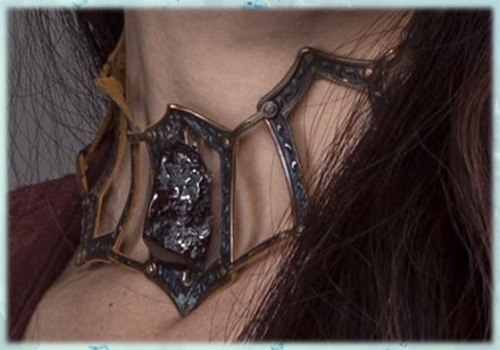
One of Mel's gowns is made from a jacquard damask from the Rubelli Venezia collection in reverse.
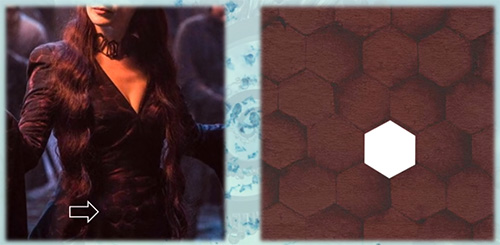
The manufacturer Rubelli states that the pattern comes from the ceramic ornamentation of the mausoleum of Sem Sultan in Bursa, dating back to the end of the 15th century.
Hexagon shapes sometimes occur in nature. But one of the best-known examples is the honeycomb.
Actually, Melis means “honey” in Greek and the name Melissa means “bee” in Greek. Also, in Greek mythology, Melissa was a mountain nymph who fed baby Zeus honey and hid him from his father Cronus, who was intent on devouring his progeny.
But it's more likely that Melisandre's name derives from the Melissae which translates as “the bees”. It was the name given to a triad of sisters in ancient Greece. The priestesses of The Bee were able to see the future, interpret signs and omens provided by nature and the earth. That, essentially, makes Melisandre the Queen Bee of Westeros.
From Season 6, both the Red Priest Zanrush and the high-ranking Red Priestess Kinvara wear costumes edged with linked hexagons. Kinvara’s gown and choker are also similar to Melisandre’s.
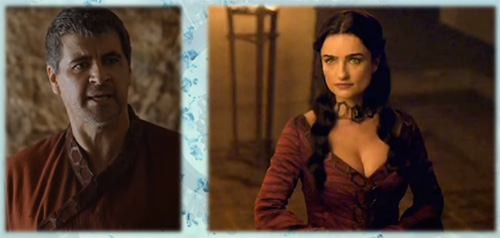
In season 2, we are introduced to Quaithe of the Shadow and, like Melisandre, she’s a shadowbinder.
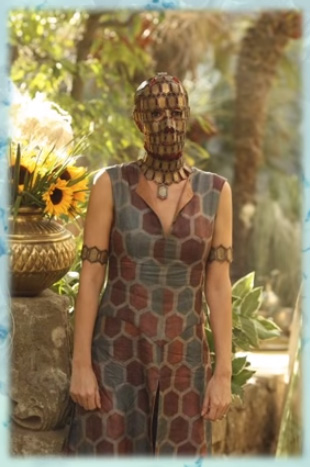
Of this look, Michele Clapton said, “I used the same shaped links as I used on Melisandre's necklace to have a mask made, which was quite articulated”.
Her costume is also block-printed with the same motif.

Here are Quaithe’s mask and Melisandre's choker side by side so you can see the similarities.
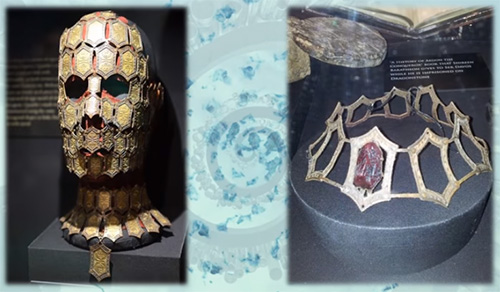
In Season 7, we see that the hexagon shape fits nicely into Danny and Missandei's dress openings.

Spiral symbol
Michele Clapton created this fantastic, architecturally designed gown created from laser-cut leather in a spiral pattern.
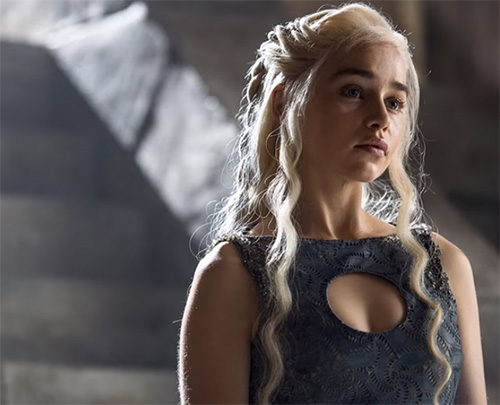

Here's a close-up of the laser-cut spiral, taken from Danny's gown, compared to the Targaryen sigil, also in a spiral formation.
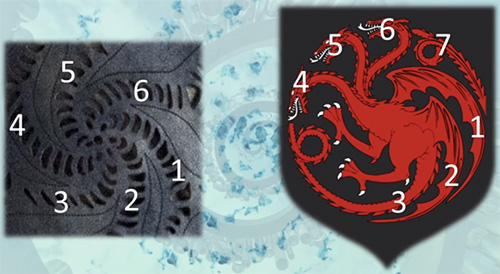
We saw this symbol also in the formation of a 7-arm spiral of dead horses by the White Walkers.
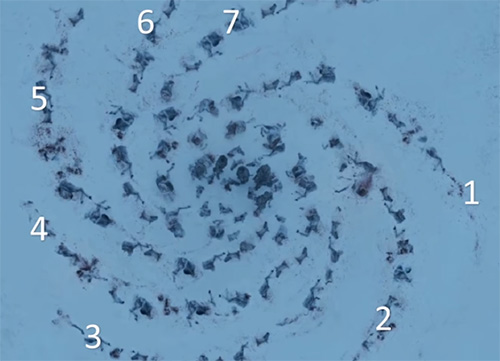
And in Season 6, by the Children of the Forest.
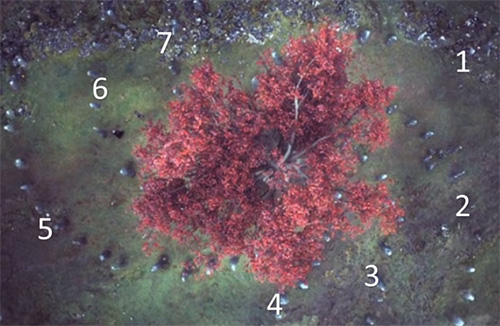
Spirals are some of the oldest geometric shapes in ancient artwork, dating back as far as the Neolithic period which was thousands of years before writing.
Like the circle symbols, we also saw the spiral carved into the wall of the caves of Dragonstone, also believed to be by the Children of the Forest.
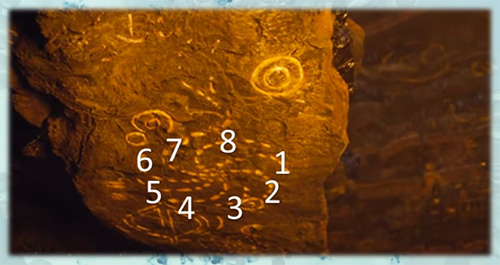
Petroglyphs, like these stone carvings, date back to prehistoric peoples. And you might notice that this spiral has 8 arms instead of 7, so this might be a bit of continuity error.
Like the hexagon, the spiral is seen in nature or in a hurricane or typhoon.
Also, the forward and backward swirls are complementary, similar to the dual energies of Yin and Yang. The swirl on Dany’s dress, meanwhile, is forward-leaning, therefore representing the male energy and, like Sansa's pendant, is not balanced without the female energy.
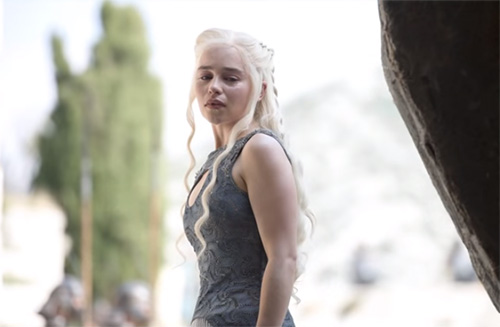
Memento Mori
Memento Mori is a direct translation from Latin meaning “Remember death”. It's an object serving as a warning or reminder of death, such as a skull.
And like Game of Thrones’ saying “Valar Morghulis”, which translates to “all men must die” in High Valyrian, memento mori is the medieval Latin Christian theory and practice of reflection on mortality.

Here are two examples of 17th-century rings with memento mori, featuring ruby gems.

According to The Met (The Metropolitan Museum of Art), memento mori jewelry emerged in the Renaissance when goldsmiths and other artists developed moralistic images that contrasted youth and beauty with death and decay.
In Game of Thrones, the first example of memento mori is on Cersei's first black jacquard mourning gown, the one that she wears when she presides over Joffrey's body in the “Great Sept of Baelor” just after his death.
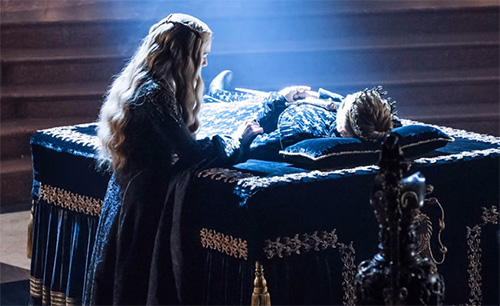
This elaborate beating is by embroidery artist Michele Carragher and features brass, jump rings, and seed beads.
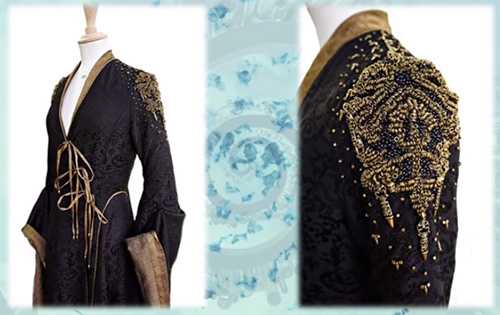
But if you zoom in really close, you can see these little brass skulls, hiding amongst the larger cluster of jump rings.
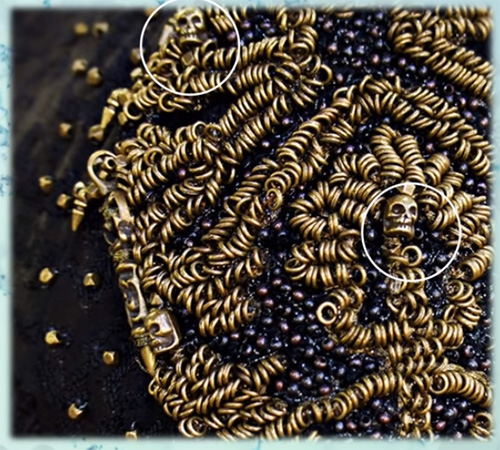
The second example of memento mori is Cersei's second mourning gown.
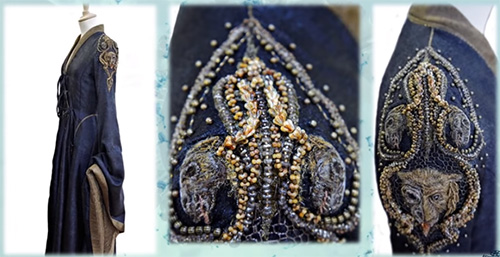
Here, if we look at the embroidery and beading by Michele Carragher, we see in the middle image the profile of 2 lion skulls. And then on the far right, there is a lion head with half of the face – a skull. Add to this an assortment of beads that look like bone vertebrae or even animal teeth – this symbolism captures memento mori.
Dagger symbol
If we look closely, the fanciful dagger motif appears on multiple costumes from seasons 3 to 5.
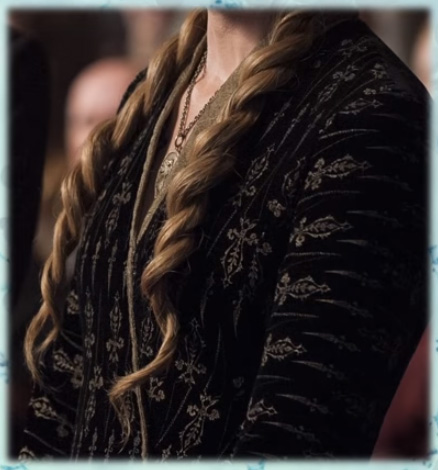
The daggers first make an appearance on Joffrey in Season 3 Episode 4. The costume is also featured prominently on an Entertainment Weekly cover. The golden dagger motif on a crimson background.

The costume designer Michele Clapton has stated in interviews that the wardrobe weaves and prints many of the show's fabrics. This fabric must have been custom-made for the show.
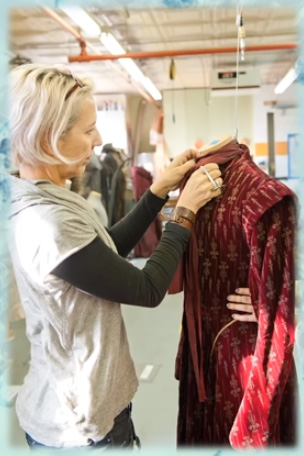
It is known that during a fitting with his tailor, Joffrey demanded a fabric with no flowers. And when the tailor presented the dagger fabric swatch, Joffrey said, “Much better!” Maybe on the surface level, Joffrey wants to appear more dangerous than he actually is.
Here he is, having a full-on meltdown in Season 3 Episode 10 in the same costume.

And then flash-forward to Season 4 Episode 3. Joffrey is laid to rest in a black funeral coat printed with the same dagger motif.
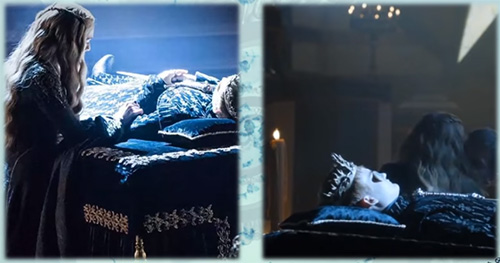
Picking up the torch, Cersei appears at Tyrion’s trial in a gown made from the black dagger fabric.
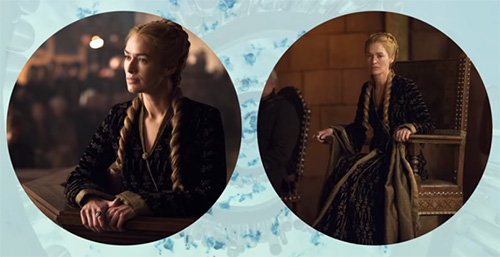
And then in Season 5 Episode 3, Cersei incorporates it into the lining of her kimono sleeves.
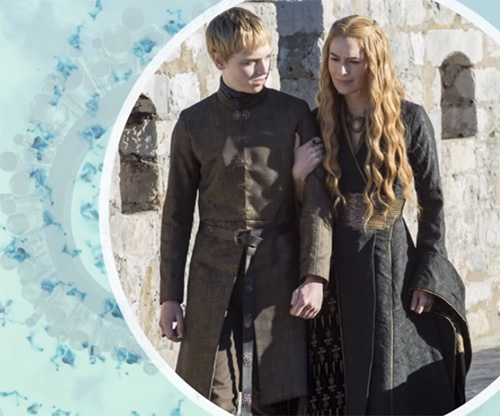
So, what might this mean? There is a significant dagger in “Game of Thrones” called the “assassin's dagger” that Arya Stark now possesses. But it doesn't resemble the golden motif dagger that we see on the fabric.
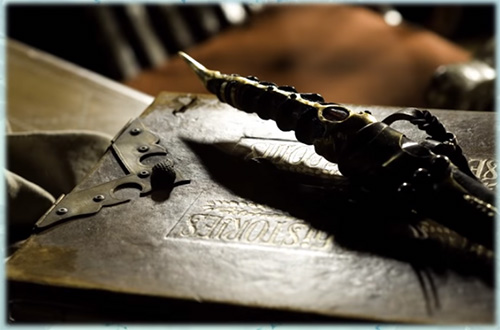
This type of dagger more closely resembles a dagger glyph used in typography, which closely resembles a cross. In typography, the dagger is commonly referred to as an obelisk with an ancient Greek origin meaning “spit, nail, or pointed pillar”.
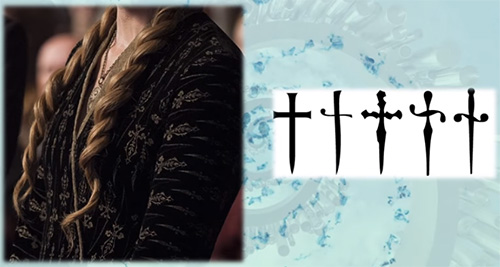
Obelisk can also mean “needle”, like in the case of Arya Stark’s weapon.
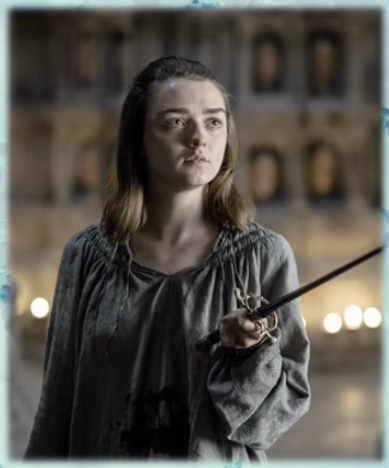
Interestingly, in typography, the dagger is also used to indicate death, extinction, or obsolescence. When placed immediately before or after a person's name, the dagger indicates that the person is deceased. In this usage, it is referred to as the “death dagger”. This sort of sums up Joffrey's arc nicely.
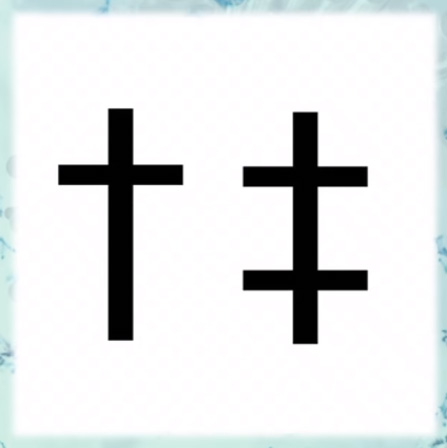
But what might this mean for Cersei? It occurs that this type of dagger in the motif is a crossbar dagger, like the one Catelyn is holding in this scene from Season 2.
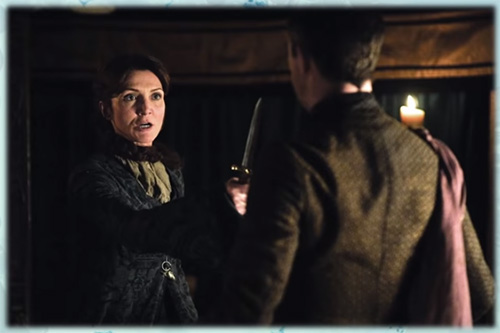
The crossbar is sometimes called the “quillon”.
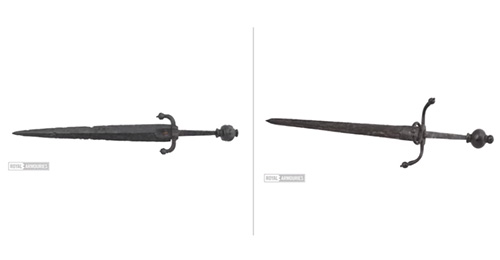
Both of these daggers pictured here are from the Royal Armouries collection in the UK and date from the 16th century.
With the dagger from Cersei and Joffrey's costumes, the crossbar or quillon forums an S-shape. Quillon daggers remain popular in the 16th century after the sword type it resembled had fallen out of use.
Jamie uses a quillon dagger to kill the Stark captain Jory Cassel back in Season 1. Notice that the quillon is S-shaped, just like from the motif.
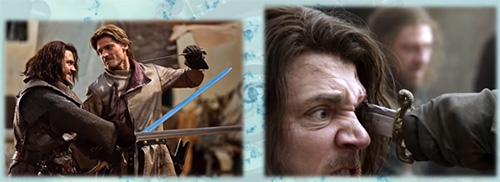
Daggers can also represent cultural symbolism. They may be associated with deception, stealth, and/or treachery due to the ease of concealment and surprise that someone would inflict with one on an unsuspecting victim.
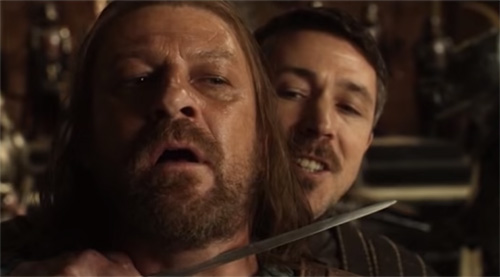
The imagery of the dagger paired with a cloak is also associated with the archetypal spy or assassin. The cloak is worn to hide one's identity or remain hidden from view and the dagger – a concealable and silent weapon. A cloak&dagger attack is one in which a deceitful, traitorous, or concealed enemy attacks a person. Arya's cloaks in these circumstances are her masks.

And then there’s one final possible meaning. As you can see from this image that's translated as “necessary instruments for the magical arts”, ceremonial daggers are an important tool used in many pagan rituals.
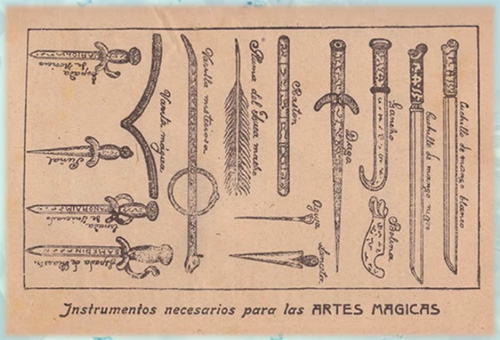
A ceremonial blade called an “anime” appears in certain versions of the “Key of Solomon”, a grimoire or book of spells, originating in the Middle Ages. The anime’s primary use is to channel and direct psychic energy, generally conceived as “etheric fire”.
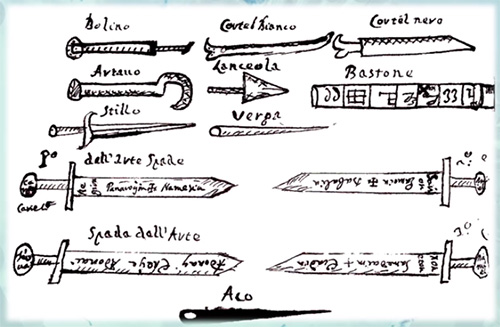
(c)
Read also:
Costumes of Jon Snow from Game of Thrones. Are they historically accurate?
Stage costumes of Olenna Tyrell from Game of Thrones. She’s got charming pillbox hats with wimples
GOT Red Wedding show costumes. Let’s recall the top-10 lovely and weird outfits


